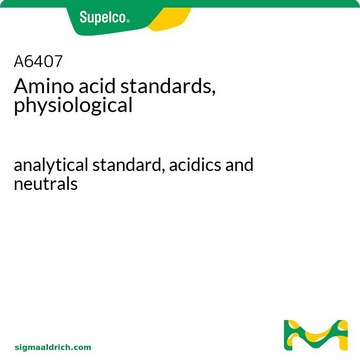A6282
Amino acid standards, physiological
analytical standard, basics
Zaloguj sięWyświetlanie cen organizacyjnych i kontraktowych
About This Item
Polecane produkty
klasa czystości
analytical standard
klasy chemiczne analitów
amino acids, peptides, proteins
metody
HPLC: suitable
gas chromatography (GC): suitable
kolor
colorless
Zastosowanie
food and beverages
Format
neat
temp. przechowywania
2-8°C
Szukasz podobnych produktów? Odwiedź Przewodnik dotyczący porównywania produktów
Zastosowanie
Refer to the product′s Certificate of Analysis for more information on a suitable instrument technique. Contact Technical Service for further support.
Inne uwagi
Amino acids and related compounds are 2.5 μmoles per mL.
Ta strona może zawierać tekst przetłumaczony maszynowo.
produkt powiązany
Numer produktu
Opis
Cennik
Hasło ostrzegawcze
Warning
Zwroty wskazujące rodzaj zagrożenia
Zwroty wskazujące środki ostrożności
Klasyfikacja zagrożeń
Met. Corr. 1
Kod klasy składowania
8B - Non-combustible corrosive hazardous materials
Klasa zagrożenia wodnego (WGK)
nwg
Temperatura zapłonu (°F)
Not applicable
Temperatura zapłonu (°C)
Not applicable
Wybierz jedną z najnowszych wersji:
Masz już ten produkt?
Dokumenty związane z niedawno zakupionymi produktami zostały zamieszczone w Bibliotece dokumentów.
Klienci oglądali również te produkty
Carolina Soares Moura et al.
PloS one, 9(1), e83437-e83437 (2014-01-28)
Whey protein hydrolysate (WPH) intake has shown to increase HSP70 expression. The aim of the present study was to investigate whether WPH intake would also influences HSP90, HSP60 and HSP25 expression, as well as associated parameters. Forty-eight male Wistar rats
Sandra Anne Banack et al.
Marine drugs, 5(4), 180-196 (2008-05-09)
Diverse species of cyanobacteria have recently been discovered to produce the neurotoxic non-protein amino acid beta-methylamino-L-alanine (BMAA). In Guam, BMAA has been studied as a possible environmental toxin in the diets of indigenous Chamorro people known to have high levels
A S Davison et al.
Molecular genetics and metabolism, 125(1-2), 135-143 (2018-07-28)
Concerns exist over hypertyrosinaemia that is observed following treatment with nitisinone. It has been suggested that tyrosine may compete with tryptophan for uptake into the central nervous system, and or inhibit tryptophan hydroxylase activity reducing serotonin production. At the National
Katharina Trunk et al.
Nature microbiology, 3(8), 920-931 (2018-07-25)
Interactions between bacterial and fungal cells shape many polymicrobial communities. Bacteria elaborate diverse strategies to interact and compete with other organisms, including the deployment of protein secretion systems. The type VI secretion system (T6SS) delivers toxic effector proteins into host eukaryotic
Rituraj Pal et al.
Nature communications, 9(1), 4351-4351 (2018-10-21)
The mechanistic target of rapamycin complex 1 (mTORC1) regulates cell survival and autophagy, and its activity is regulated by amino acid availability. Rag GTPase-GATOR1 interactions inhibit mTORC1 in the absence of amino acids, and GATOR1 release and activation of RagA/B promotes mTORC1
Nasz zespół naukowców ma doświadczenie we wszystkich obszarach badań, w tym w naukach przyrodniczych, materiałoznawstwie, syntezie chemicznej, chromatografii, analityce i wielu innych dziedzinach.
Skontaktuj się z zespołem ds. pomocy technicznej













